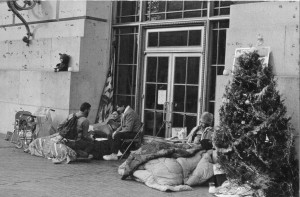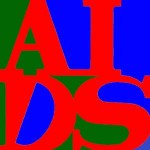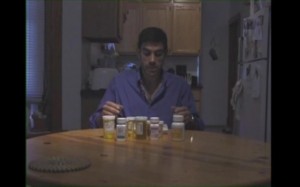Going by bus in Los Angeles is always an adventure. Not just that it takes you ages getting from one spot to the other it offers you an insight in the American society you would not expect on the first sight. Are all the homeless people being in such a bad shape a marker for the financial crisis and the expression of this deep gap evolving out of capitalism? Without being polemic speaking about the American society in its complexity and often astonishingly ambivalences the issue of homelessness intersects with my second observation in Los Angeles and San Francisco. It is this presence and visibility of AIDS I baldly do not notice that much in Europe. But AIDS nowadays is not getting visible by people marching in the streets, by obituaries plastering the newspapers or by vigils you can see in the photo alongside and that for me represents the intersection of the precariousness of AIDS victims as/and homeless people. Homelessness was much more a threat to gays with AIDS in the United States than in Europe since the federal health system did not provide free drugs or health care.

(1) David Nicoletta: San Francisco AIDS Vigil, 49th Continuous Day of Protest (Dec. 14, 1985)
Today´s visibility of AIDS on the contrary consists of huge advertisements for AIDS Walks highlighted by smiling and “hollywoodesk” faces or “Out of the closet” thrift shops where you can get a testing easily while shopping. This can not be mentioned without considering the history of AIDS activism in the 1980ies and 90ies when it was at stake to march for an unrestricted access to medication. Nevertheless AIDS turned out to be implicated in everyday live activities like shopping and to be a self-evident part of the private and public without scandalizing images of suffering bodies, without the screaming capitals of the Logo of General Idea or the destructive self representations.

(2) General Idea, AIDS, 1987

(3) Carl M. George, DHPG Mon Amour, 1989, 12:00
Instead of Keith Haring´s subway drawings addressing the aspect of public manipulation of private sexuality for fundamentalist interests blaming gays for bringing the plague I saw in the subway station of San Francisco advertisements trying to evoke nostalgia to bid for donation.
Does visibility of AIDS mean commensurability and commercialization nowadays? Is this the newly habit Gregg Bordowitz as an AIDS activist and video artist tries to challenge in his documentary “Habit” by contrasting his everyday consumption of drugs with the struggle of activists in South Africa to gain access to them at all?

(4) Gregg Bordowitz, Habit, 2001, 52:23 min
By doing this it seems more than just telling a progressing narrative of the development of AIDS as an illness almost overcome in the western states like timeline projects regarding the representation of AIDS try to establish (5). That is why I was wondering how homelessness perceiving in the public sphere of LA let me think about AIDS and its changed visualization. While the visualization of AIDS changed in terms of marketing and commensurability it still evokes precariousness, poverty and injustice.
(1) Collection of the GLBT Historical Society
(2) AIDS. 1987. Acrylic on canvas, 72 x 72″ (182.9 x 182.9 cm). Private collection, Chicago. Photo courtesy General Idea
(3) http://lux.org.uk/collection/works/dhpg-mon-amour
(4) http://www.vdb.org/node/3362
(5) Group Material, AIDS Timeline, 1990; ONE AIDS Timeline, 1981-2011
